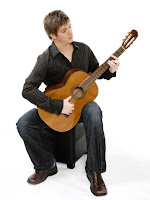TECHNIQUE: Guitar Posture & Hand Position Mastery...
Proper guitar technique is not something that every guitar player is aware of or even takes seriously. This is mainly because improper posture and bad sitting habits will not immediately result in injuries...
Over the long term guitar players who sit poorly can get a whole host of issues. These can range from back pain, to shoulder issues, problems with; neck, elbow, arm and wrist pain, RSI (repetitive strain injuries), tendonitis, CTS (Carpal Tunnel Syndrome) and other nasty side effects.All due to bad sitting positions.
This is certainly not every guitar player’s destiny, but it’s not out of the question either. There is however good news! Proper posture can prevent a lot of these injuries and it makes guitar playing easier, more relaxed and more pleasant.
Good hand positioning is really important to learning how to play guitar more effectively and properly. Every detail makes all the difference in the world.Read over the ideas presented below to learn more about guitar posture.
Sitting position
Sit down on a chair, and place your right foot on the floor and elevate your left foot using a guitar players foot stool, keeping your back straight.
Place the guitar on your left leg (if you’re right-handed) and hold the guitar around the central area of your stomach and chest. Have the neck of the guitar pointing upward to the ceiling.
Don’t use the left hand to support the neck from leaning down towards the floor, instead let your upper right arm rest on the upper part of the guitar body to avoid this. Make sure all this feels comfortable.
Left hand position and finger placement (fretting hand)
The thumb of your fretting hand should rest behind the neck of the guitar for the majority of playing situations. Place it approximately between your first two fingers. Make sure to bend all your knuckles (1st, 2nd and 3rd).
Use the tip of your fingers to press down the strings and place them as close to the forward fret wire as possible. (Do not place your fingers on the fret!).
Keep your fingernails short, so they cannot touch the fret-board.
Right hand position (strumming hand)
Rest your upper right arm on the upper part of the guitar body, and have your right hand floating comfortably above the sound hole keeping a relaxed feel in your arm, wrist and your hand.
Strumming technique
There are several strumming techniques for guitar playing.
Here is one that is commonly used:
Place your thumb against your index finger and hold them together. This gives you decent support. Bend your middle, ring and pinky slightly towards the palm of your hand.
Down-strum with the nail of your index finger against all the strings and then up strum with the nail of your thumb or the under-side of the index finger.
Dynamics are affected by how you perform the up-strum. You can also play with your index finger and thumb separately which gives you a more tender sound. You can also grow your fingernails a bit to give you a more clear sound similar to using a pick.
Using a pick (plectrum)
Hold the pick between your thumb and index finger. Place the pick on the top side of your index finger and clamp your thumb down on top of it. Hold the pick firmly when playing single notes. Lighten up on the pick when strumming. The grip you make on the pick affects dynamics (how loud or how soft you play).
Fingerpicking position
Rest your forearm on the top front edge of the lower bout to stabilize your hand. Hold your hand above the sound hole, make sure your hand and arm are aligned and bend your knuckles slightly.
The most common approach is playing the bass strings (4th, 5th and 6th string) with the thumb, 3rd string with the index finger, 2nd string with the middle finger and the 1st string with the ring finger. Other variations are also used. Use the tip of your fingers to pluck the strings.
Prevent injuries
Keep your back straight, lengthen and align your spine. Relax your neck and shoulders (don’t raise your shoulders). Avoid or release any tension in the arms, wrists, hands and fingers.
Take a break and stretch every now and then - especially if you’re playing for an extended amount of time. If you feel strain or pain take a rest and let your body heal.
Make sure you eat healthy, sleep well and exercise regularly. These three pointers are of great influence to your daily practice.
Be aware and listen to your body.
___________________________________________________
GET GOOD NOW - JOIN THE MEMBERS AREA









